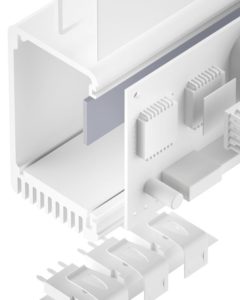GAP-FILLER

PRODUCT DESCRIPTION
In all electronic applications, heat is lost during operation. In order to maintain the function of the components used in the long term, this heat must be dissipated. Gap fillers or gap filler pads are used for this purpose as Thermal Interface Materialien (TIM). They almost completely and permanently fill gaps caused by tolerances, differences in height or different expansion coefficients of the materials used in the electronic components. Depending on the application, either thermally conductive pads or corresponding pastes (fillers) are used. Both have a natural self-adhesion, which is why no additional bonding agents are required for adhesion in use. This makes them suitable for easy pre-assembly.
VARIANTS
- Soft, ultra soft, elastic, plastic, dispensable
- Double or single sided adhesion through laminate or surface treatment or adhesive
- Reinforcement by glass fiber laminate
- Silicone, silicone-free or low volatile siloxanes (LV)

Many electronic applications today consist of a large number of components that have different heights, that means they are not planar. This leads to gaps and tolerances that must be compensated for as part of efficient Thermal Management. This is because these components generate heat loss during operation. In order to avoid overheating and thus damaging the components and reducing their operational life, the thermally conductive properties of paste-like gap fillers and solid gap filler pads are used in such applications today. Thanks to their soft and long-term elastic character, they compensate for height differences between components. This allows them to be connected together to a single heat sink or to a cooling housing. Above all, they minimise the thermal resistance between the electronic components and the heat sink, thus protecting the entire system from overheating and rapid ageing. Thanks to their elasticity, they also reduce vibrations which sensitive applications are exposed to.
The exact composition of thermal conductive materials is matched to the thermal conductivity and thermal contact in the application. In addition, there are aspects such as electrical insulation properties, maximum operating temperatures in which they operate. The available space and the budget also play a role. Most products are based on silicone elastomers, which are filled with thermally conductive fillers – often ceramic powders based on aluminium oxide, zinc oxide or boron nitride. Among silicones, there are polymers with a very low content of volatile siloxanes (Low Volatile LW), which can play a role in the protection of contacts and the property of not repelling paint (LABS / PWIS).
At HALA we offer both silicone-containing and minimal siloxane as well as 100% silicone-free products.
Liquid or paste gap fillers are available as either 1-component (1K) or 2-component (2K) fillers.
1-part materials are highly viscous thermally conductive pastes that remain permanently liquid and behave thixotropically form-in-place. They can be applied with autodispensing equipment or by hand.
In the case of 2-part gap fillers, the two components of the thermally conductive material are stored separately and, in the case of large-volume applications in automated production lines, are only mixed in a mixing tube via a lifting and dosing unit immediately before application and dispensed onto the application. There, the material polymerises until it is cured. These dispensing systems are associated with investments. For small-volume applications, manual dispensing is preferred. These materials are suitable for compensating extreme tolerances and gaps in non-planar structures. Pressure is not necessary and does not occur, thus avoiding stress on components. This allows precise positioning (form-in-place) as well as placed curing (cure-in-place).
Typically, gap fillers are used wherever the distance between electronic components and the heat sink is quite large and the different heights of the components make it difficult to connect them to the heat sink. Typical applications are
– in the automotive sector (e.g. infotainment, control units, bus controllers, servo motors, power semiconductors, batteries for e-mobility),
– in the industrial and IT sector (e.g. notebooks, industrial computers, routers, servers, memory, graphics cards, driver chips, high speed camera, sensors)
– power supply (e.g. inverters, inductors)
– in medical technology
– as well as in the field of consumer electronics.
Basically, a distinction is made between liquid or paste-like gap fillers and solid elastomeric gap filler pads. There are different versions of both, which differ primarily in their thermal conductivity and compliance through compression. HALA has the right heat-conducting material in its range for almost every requirement: soft, ultra soft, elastic, plastic, adhesive on both or one side or reinforced with glass fibre laminate, dielectrically protected by glass beads are just some of the properties of gap-filling products available from us. In addition to the classic products based on elastic silicone polymers, we also offer silicone-free and low-siloxane (LV low volatile) variants, which are used where silicone is critical or undesirable.
Thermally conductive materials that are applied as pastes in a liquid state are called gap fillers. In most cases, the thermally conductive material is mixed from two components in a dosing system and applied to the application. Companies therefore need a corresponding dispensing system for the application. Such 2-part fillers cure at room temperature by addition cross-linking. This polymerisation can be accelerated by increased temperature. Alternatively, there are 1-part fillers, putties, that do not vulcanise. Since no or only minimal pressure is exerted during assembly when applying liquid 1-part or 2-part Thermal Interface Materials (TIM), they are an ideal solution especially for mechanically sensitive components such as FPGA, BGA, amplifier chips, CPUs, etc.. Since gap fillers completely fill all unevenness and gaps, they enable particularly efficient heat transfer between the component and the heat sink.
Gap filler pads or flexible heat conducting pads are soft, elastic sheets with heat conducting and mechanical compression properties. They also compensate for height differences between components and have the same basis as paste-like gap fillers. The sheets are pre-cut to the desired shape by high-precision automatic plotters or in the die-cutting process and then compressed to the set thickness during assembly. This results in close permanent pressure contact between the component and the heat sink, which ensures reliable heat dissipation. Since pressure is always applied during application and afterwards, classic harder gap filler pads are not suitable for very pressure-sensitive components.
Thanks to an advanced process, HALA can adapt some of its gap filler pads three-dimensionally and thus enable a quasi multiplane connection of the components through one pad – without high pressure and independent of the height. This is because the shape of the pad is precisely tailored to the individual tolerances and heights of the application.
Typically, modern gap filler pads are made of the highest quality silicone elastomers filled with ceramics. However, some applications are sensitive to silicones or their inevitable outgassing of volatile siloxanes. This is the case, for example, with switches, relays and open contacts. In such applications, there is a latent risk of fogging and deposits on contacts, which increases the electrical resistance and leads to field failures. In the process, the silicon contained can be converted into insulating silicon dioxide with the consequence of system failure. Silicone outgassing is also undesirable in automotive manufacturing, as it impairs optimal adhesion of the lack. For such applications, silicone-free and minimally siloxane gap filler pads without paint repellency properties (LABS / PWIS) have been developed. HALA offers these as pads in material thicknesses of up to five millimetres and more. With the ultra-soft elastomers used, even very low pressure is sufficient to achieve optimum contact. Formulations and filling enable high thermal conductivities of up to 10 W/mK.
Numerous online shops offer thermal conductive materials. Many of these shops are primarily designed for private users who buy fillers and pads individually or in small quantities. Most shops also offer prefabricated standard versions that are not tailored to specific requirements and therefore do not ensure optimal thermal management. For the professional user, it must also be ensured that a solution is available for the long term and can be scaled cost-effectively for increasing production volumes, and that quality management processes are strictly adhered to. At HALA, we offer you these procurement options on the one hand. But above all: with us you benefit from individual long-term expert advice that leads to the optimal thermal management for your project.
The best thing to do is to contact us directly – we can advise you free of charge and conveniently online at any time.





